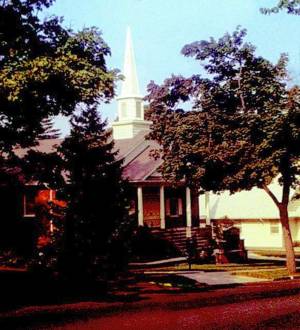Rutherford's oldest churches – Presbyterian and Episcopal – can trace their start with services held in an unheated two-story building on Ames Avenue called Union Hall. Other churches established in the 19th century were organized in members' homes, such as the Unitarians did in Henry Bell's home, which is now Rutherford Congregational Church, corner of Prospect Place and Union Avenue; and as did the Baptists in the home of Benjamin Yates at 124 Orient Way (extant).
In the mid 1920s, the Gospel Chapel was incorporated, and youngsters like Henri Larrieu (1920-2008), who grew up in this Christian church, began attending Sunday school when this chapel was completed at 116 Union Avenue in 1926. Henri had been introduced to its ministry at the hall on Park Avenue. On May 24, 1970, he and fellow elders Walter Nearpass and Guillard Thompson conducted the dedication service for its new chapel on West Passaic Avenue.
For another Rutherford church, now called the Rutherford Bible Chapel, its beginning isn't quite as clear. The church's own history says it began in the home of a founding member "before the turn of this century," meaning the late 1900s. That member, William J. Doig, established a residence in 1899 as a tenant of Carrie A. Boss. Carrie Boss owned a house and barn at the corner of Montross and Donaldson Avenues, which some believe once served the Rutherford residence of the 19th century author, Frank Stockton. The same house was later owned by Frederick W. Sheaf, elected mayor of Rutherford in 1919. It was knocked down in 1941 by Alleck Reenstra, who built a single family house at what is now 324 Montross Avenue.
William Doig, a native of West India, died in the old Montross Avenue home in April of 1902. He was given a funeral service by his fellow congregants at Ivison Library Hall, a stone building once occupied by the Presbyterian Church, given to the community by David Ivison. Space in Ivison Hall was rented to the church, then called Gospel Hall, as well as other organizations as a means to financially support the newly formed Free Public Library. Gospel Hall also met in the Franklin Building, 37 Park Avenue (extant), and later incorporated as Gospel Chapel. It was subsequently renamed Rutherford Bible Chapel. It is currently situated at 161 West Passaic Avenue, the former residence of another important church founder named Arthur Mauger, a former Brooklyn resident who died rather tragically in 1932.
Mauger was an important church leader in the early part of the 20th century and was among those who later helped build this congregation's first church in 1925 at the corner of Union Avenue and Grove Street. This quaint, bungalow-styled structure at 116 Union (extant) served as home for the church for 44 years. It was at this location that the congregation took hold and grew, having established youth groups among children in high school, grammar school, and the primary grades. As importantly, the Union Avenue chapel attracted an interracial group of youngsters, drawing from the surrounding black neighborhood of Wood Street and Washington Avenue. These youngsters were treated to a Friday evening of arts and crafts after listening to a half-hour Gospel lesson.
But Doig and Mauger were not Rutherford's earliest followers of this particular religious assembly, which began in Plymouth, England. It evolved from people who were dissatisfied with the Anglican Church and became known as the Plymouth Brethren Christian Church. Some of its adherents immigrated to America in the mid-1800s, settling in places like Greenpoint, Brooklyn and parts of northern New Jersey.
|

PHOTO COURTESY/ROD LEITH
In the mid 1920s, the Gospel Chapel was incorporated, and youngsters like Henri Larrieu
(1920-2008), who grew up in this Christian church, began attending Sunday school when this chapel was completed at 116 Union Avenue in 1926. Henri had been introduced to its ministry at the hall on Park Avenue. On May 24, 1970, he and fellow elders Walter Nearpass and Guillard Thompson conducted the dedication service for its new chapel on West Passaic Avenue.
|
One of the earliest known Plymouth Brethren adherents in New Jersey was an English emigrant named Eve Ann (nee Modridge) Norsworthy (1844-1915), who was married to Samuel B. Norsworthy, a mechanical engineer who brought his family to New Jersey in 1883, first settling in Orange and then Rutherford in 1885. According to a 1918 biography of her daughter, Dr. Naomi Norsworthy, Mrs. Norsworthy favored Rutherford because of its close proximity to New York, where she could meet with a small group of Plymouth Brethren followers. In a house built on West Passaic Avenue, across from Grace Episcopal Church, Mrs. Norsworthy raised three children, providing strict religious schooling at home. Later sold to Franklin D. Acker, the Norsworthy house was the first home of William Carlos Williams and wife, Flossie, after their marriage in 1912.
The teaching of the Plymouth Brethren held "an enormous power in Eve Ann's life and through her, in Miss Norsworthy," according to her biographer, Frances Caldwell Higgins. Naomi Norsworthy was, by all accounts, one of the most brilliant graduates of the old Rutherford Park School in 1893. She studied at Trenton Normal School, and then Columbia University, where she received her doctorate in 1904. She excelled in the Columbia environment as a teacher, university leader, and author, but Dr. Norsworthy never forgot the tenets taught her from her mother's Holy Bible.
"The cardinal principal of her belief was that the compelling duty of every human life is consciously and ceaselessly to mould personality after the Ideal of Him who brought 'new feeling fresh from God,' who taught what faith is, what service is, and what consecration is," Professor Higgins states in the biography, "The Life of Naomi Norsworthy."
Miss Norsworthy, who was born in New York City on Sept. 29, 1877, died there on Christmas Day, 1916.
- See more at: northjersey.com/news